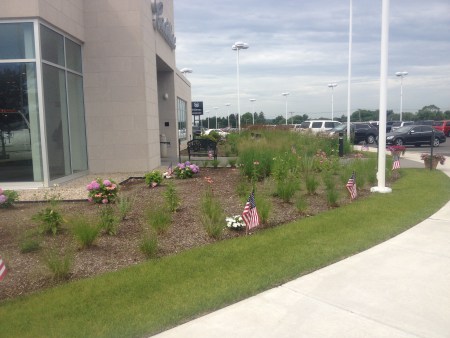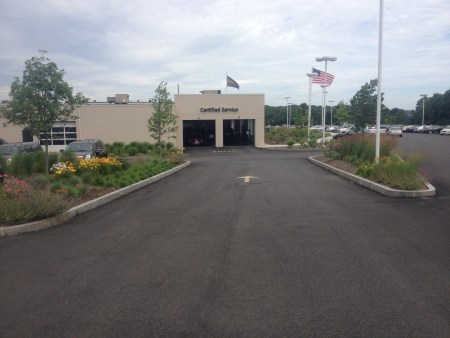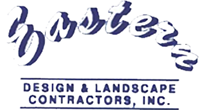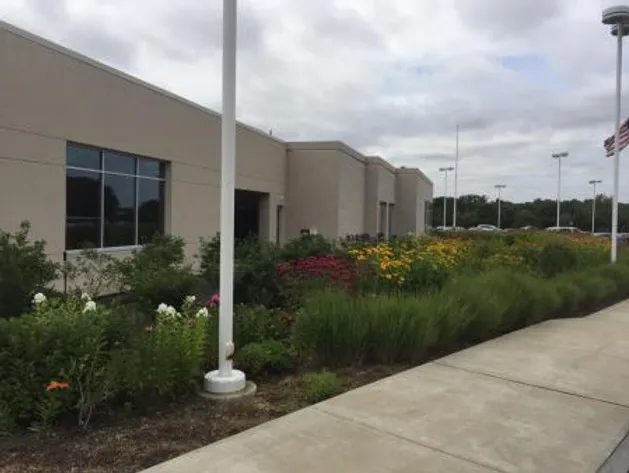Sustainable Landscape Development is pretty much “Old News” now! Or is it? Sister companies from Wrentham, MA.; Eastern Design & Landscape Contractors, Inc. and Grounscapes Express, Inc. Have been practicing Sustainable Landscape Development for at least fifteen years now. It has been an evolution and a steep learning curve but nonetheless the principles, and objectives have always been there. The principles are built on ecological systems and practices have developed and evolved.
We would like to describe a typical example that we will present here. Our client is Norwood Cadillac
This is a well – established business that has served the community for a long time. They were our client for years and we provided a high standard of landscape services for them. The facility is up on top of a hill with large sloping areas of turf grass and typical woody shrubs and trees that filled their landscape. Our clients were satisfied with the services that we provided them.
They were having difficulty in keeping up with the turf irrigation. The lawn turf was on sloping ground and the three wells that were supplying the water for the turf and the other landscape plantings were having problems just supplying enough moisture to sustain the landscape. The pumps that were also pumping this water were under a great deal of wear and stress and were constantly needing repairs.
John Engwer, the owner, and Principle of these two sustainable landscape development companies, was trying to maintain these pumps especially during the heat of the summer season. With this evidence -based information, John Engwer, took it upon himself to try and alleviate this situation and bring some balance to the landscape and his client. The Problem as defined in Sustainable Landscape Development terms, always must address three parts; Economic, Environmental, and Societal needs. This is if the solution is to truly become sustainable.
The Sustainable Solution:
The first and most glaring problem was the water use and its related costs. The turf area was eliminated. Warm season native grasses and perennial flowering plants were planted. The same has been done to the traditional woody landscape plantings that also require water, labor for maintenance, and petrochemical inputs to treat the diseases and pests that are brought on by environmental stressors in the landscape. These woody shrubs and trees are being removed over time and replaced by herbaceous perennials and warm season grasses. The selection of these plants are plants that are well suited to the existing environment and will need low inputs for there ongoing health, maintenance.
These plants were planted in phases over time. They were planted in areas that were sectioned off and planted over seasons and based upon their importance and aesthetic values for the overall look of the landscape. The plants were planted in such a way that they were spaced apart to create a full look but they were spaced to accommodate their growth and for the eventual separation or division of each plant to create additional plants to cover more planting areas with the same amount of plants that were planted originally. The most important part of this solution was that at no time the cost of the renovation was more expensive than what the original yearly landscape budget would have been costing.
The direct and Embodied Costs:
The Economic Costs as outlined;
- The continuous operating and repair costs to correct the functioning of the pumps’
- The continuous cost for maintaining this large area of sloping turf.
- Mowing, trimming, edging, etc.
- Lawn material inputs; herbicides, fungicides for the grass.
- The cost of the water. The landscape was consuming one million gallons of water over the course of growing season.
- The cost of the repairs and maintenance of the irrigation system.
- *These costs were incrementally increasing as time went on.
The Sustainable Benefits Outlined
The Economic Benefits:
- Firstly, there were no costs related to the use of the pumps, because the pumps were no longer needed!
- Eliminating the lawn area meant that there were no longer any related costs.
- Water costs were eliminated and the use went down to zero!
- The irrigation system was modified to a low volume low flow system that was needed for the establishment of the new plants and possibly in times of severe drought.
- The expense will decrease over time as the landscape plantings mature and their maintenance will cost a fraction of what the existing budget was and would have become over time.
The Environmental embodied costs:
- The excessive demand for water was drawing down the local aquifer and water Reserves.
- The need for electricity to continually run these pumps. This energy was most likely from petroleum based sources. Therefore, the expense that is embodied in these materials from extraction, processing, storing, transporting, and the waste materials resulting from these production modes produces undo stressors to our water ways, roads, and atmosphere.
- The landscape inputs are also made from petrochemicals and produce similar environmental stresses.
- The equipment used in performing these services, their manufacture, operation and maintenance also adds to the same.
- The storm water runoff of water and lawn materials ends up in our waterways.
The Environmental Benefits:
- The demand for water was reduced and the plantings could sustain themselves with the average seasonal precipitation rates.
- The entire landscape was running on energy derived by the sun.
- The storm water runoff would be considerable less as these plants along with our soil building products will re – structure the soils and allow the rainwater to percolate into the soils and supply the plantings with to meet their moisture requirements, without contaminated pollutants.
The Societal embodied costs: Human Health and Wellness
- Noise pollution from the operation of the machines.
- The toxicity from the lawn materials causes disease to our fish and wildlife.
- The toxicity from the exhaust fumes to our lungs.
- The decline in our water supplies.
- The operating costs for the auto dealership has to be accounted for in the
The Societal Benefits:
- There will not be any additional noise pollution. However, there will be the sounds of song birds singing and the sounds of all those who work and visit the dealership singing songs of delight and celebration about this landscape that is alive with colorful flowers and the movement of the flowing grasses, and the butterflies and birds flying all around.
- There will be no ill effects from petrochemicals or no disturbing sounds.
- There will be plenty of fresh water and clean air.
- The dealership will be getting such good responses from their workers so that worker productivity will be on the rise and there will be less sick days called in, and the visitors will enjoy the experience of a beautiful environment that they will purchase an automobile from them instead of someone else. The operating costs will be lowered and that may be reflected in lower prices for the consumer and higher wages for the employees?
- The building and its landscape will benefit the whole community and become a place that is more desirable and sets an example for other business.






